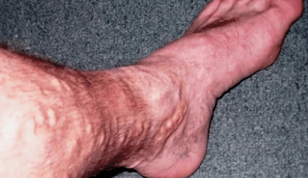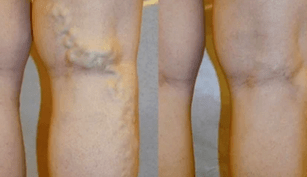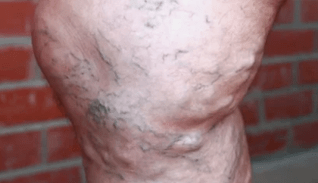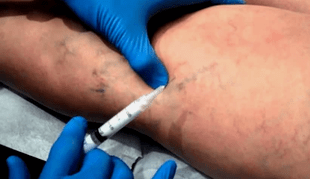According to statistics, varicose veins on the legs are about three times less common in the stronger sex than in women. Nevertheless, everyone, men, is susceptible to this disease.
Phlebologists and vascular surgeons say there is no fundamental difference between varicose veins in men and women, but unfortunately the former seek help much later when the disease has developed and is much less treatable. The article focuses on the characteristics of the course of the disease in men as well as the methods of treating the disease.
The effect of heredity and bad habits on varicose veins
First of all, it is worth understanding that in medical practice, varicose veins or varicose veins are called pathologies involving deformity of venous vessels. In this case, the latter expand, elongate, their walls become thinner, and the valve system ceases to cope with its functions. The consequences of the progression of the pathological process are as follows:

- Stagnation of blood in the veins and increase in venous pressure.
- Violation of blood circulation results in impaired lymph outflow.
- Tufts of blood vessels, also known as spider veins, appear.
- Vascular rupture and appearance of hematomas.
- Incidence of trophic ulcers.
- Increased risk of thrombophilia.
Studying the etiology of varicose veins, doctors concluded that the disease is more likely to develop due to a genetic predisposition. However, the hereditary factor does not affect the varicose veins themselves, it tends to weaken the valve system, resulting in the venous valves weakening and wearing faster. This process causes damage to the blood circulation in the vascular bed and, as a result, the formation of congestion, deformation of the veins, i. e. very varicose veins.
In addition, bad habits, which primarily include smoking and alcohol, play an important role in patients' medical histories. Abuse of tobacco and alcohol products negatively affects the functioning of the cardiovascular system, as well as the condition of blood vessels and even blood composition. Again, citing strict statistics, both habits are more masculine, in fact, this fact places smoking and alcohol dependence among the causes of varicose veins.
However, there are not only the two causes described, but also a number of other factors that are considered most likely to list the causes of the pathology:
- Excessive stress on the legs due to excessive physical exertion due to professional activity (cooks, surgeons, etc. ), overweight, sports or other similar professional activity (loaders, builders, etc. );
- The medal has one drawback, varicose veins are caused by a lack of exertion, or by a sedentary or simply sedentary lifestyle. If we start from this point of view, drivers, office workers, and people who do little to move for other reasons, including the propensity, are susceptible to the disease;
- Considering the fact of smoking and hereditary predisposition, one of the serious and very common causes of various diseases in which blood clotting is impaired.
When it comes to hormonal disorders, wearing uncomfortable shoes and similar factors are more common in women, for the same reasons (due to a greater number of triggers), the fairer sex is more likely to suffer from varicose veins.
Main symptoms of varicose veins
As for the clinical picture of the disease, much depends on the stage of progression as well as a number of individual factors and the causes of varicose veins. However, there are a number of symptoms that men most commonly experience:

- The initial stage of varicose veins rarely disturbs the patient. There may be mild fatigue in the legs, worse in the evening, pulling or tightness, mild swelling. In most cases, men do not pay attention to such phenomena and in vain as the disease progresses and over time the symptoms become more pronounced and cause more trouble.
- As the pathological process progresses, the veins begin to appear under the skin. Initially, these are vascular networks and separate prominent enlarged veins, which are then supplemented with vascular “stars”. The further the disease progresses, the more obvious this clinical symptom becomes, in later stages of the disease, the veins bulge under the skin, form lumps, and the risk of trophic ulcers increases.
- Unpleasant cracks, feelings of leg heaviness, and swelling that occurs earlier in the late afternoon or at the end of the workday are becoming more and more felt. Over time, the discomfort becomes a systematic pain that spreads through the blood vessels affected by the varicose veins.
- In places where the network of enlarged veins and blood vessels is clearly visible, itching appears on the skin.
- Cramps, which most often affect the leg or calf muscles, can interfere at night.
Important to note!All of the described clinical signs of varicose veins usually intensify in the evening, but this is precisely due to fatigue. That is, the symptoms become more intense with increased physical exertion.
Stages of venous disease in men
As mentioned earlier, the symptoms, as well as the patient's state of health and methods of treating varicose veins, are highly dependent on the extent of disease progression. Overall, there are three stages in the development of pathology:
- Compensatory or mild- in this case, the symptoms are the least intense and the patient himself practically does not complain about anything. Already in the first stage, slightly protruding pots may appear on the legs, but men do not pay attention to this.
- Moderate- This stage of the disease is also called subcompensation. The veins are more visible on the surface of the skin, but their enlargement and deformation can still be considered insignificant, as can the pressure inside the vessel. At this stage, other symptoms intensify, edema, the feeling of tiredness, more and more often disturbing, painful feelings appear first.
- Decompensation stage- the most severe form, when the varicose veins reach their peak. There is severe swelling, intense pain that can interfere throughout the day, the veins protrude strongly on the surface of the skin and change. At this stage, vascular nodules are formed, excessively increased vascular pressure leads to damage to the walls of the veins, and hematomas appear. In particularly advanced cases, trophic ulcers and eczema occur. In the third stage, conservative treatment methods are completely weak, the patient needs surgery, the specificity of which is chosen by the doctor.

Varicose veins management
As with symptoms, the principles of treatment depend directly on the extent to which the varicose veins have developed. It is important to understand here that conservative therapy primarily bears fruit in the first, sometimes second stage of disease development, otherwise conservative treatment methods will predominantly contain the disease but do not provide an opportunity for complete relief of varicose veins. Nevertheless, it is worth considering a wide range of methods for treating pathology.
Conservative therapy
An integrated approach to treating with conservative methods is very important, which means primarily adjusting your diet and changing your lifestyle.
It is important for nutrition to limit the consumption of junk food, fatty and fried foods, sweets in large quantities, to minimize salty, spicy and acidic foods, as all of this contributes to fluid retention in the body and impairs lymphatic drainage.
When changing your lifestyle, you should try to move as much as possible without overloading your legs. It’s easy to play sports, walk regularly if you need to sit a lot at work, warm up every hour. It is very important to rule out bad habits, quit smoking and limit alcohol consumption as much as possible.
Drug therapy
Complete treatment is not possible without the use of certain medications, so when contacting a phlebologist, a specialist may prescribe medications for the following groups:
- Anticoagulants - change the composition of the blood, reducing its viscosity, which improves blood circulation and prevents blood and lymph congestion.
- Venotonics - as its name suggests, drugs in this group improve vascular tone. However, it also helps to improve blood circulation, but it is based on another principle of action.
- As a symptomatic treatment, non-steroidal anti-inflammatory drugs are prescribed in the category of ointments that reduce painful sensations and stop the inflammatory process, as well as special ointments for varicose veins, eliminating edema and other symptoms.
- In addition, compression underwear should be worn as part of conservative treatment, preventing varicose veins from progressing and generally improving the patient’s condition.
Surgical treatments
If conservative treatment does not give the desired result or the disease is too advanced, a decision will be made on the surgical procedure, in which case one type of surgery will be chosen:

- Sclerotherapy- a substance (usually in the form of a foam) is injected into a vein that sticks to the wall of a vessel, excluding it from the circulation. Over time, this vessel removes itself and is replaced by connective tissue.
- Phlebectomy- a full-fledged operation in which the anastomosis of a vein is fixed and then the affected area is excised later. This method is the most effective and at the same time radical, as it involves pruning, imposing words, and long rehabilitation.
- miniflebectomyis a variation of phlebectomy that is performed mainly on small blood vessels. A puncture is made in the skin, through which a part of the vein is pulled out using a special surgical device for later autopsy. The surgery is painless, the hole heals quickly, no rehabilitation is needed.
- Laser coagulation- a method similar to sclerotherapy, but instead of introducing a special composition into the lumen of the vessel, a thin catheter equipped with a laser is immersed there. The effect of heat causes a sclerosis effect, due to which the vessel also sticks together.























